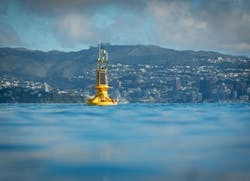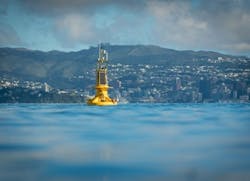Who’s a clever buoy? Smart tech to monitor water quality in New Zealand
WELLINGTON, New Zealand - A buoy with the ability to “phone home” has been deployed in Wellington Harbour today to monitor currents, waves and water quality in the harbour.
The buoy is part of a joint project between the National Institute of Water and Atmospheric Research (NIWA) and Greater Wellington Regional Council (GWRC) around monitoring Wellington Harbour health.
Named WRIBO (Wellington Region Integrated Buoy Observations), the buoy can deliver real time data of currents, waves, salinity, temperature, oxygen, chlorophyll, ocean acidification and wind.
One of its key roles will be to monitor plumes from the Hutt River that wash into the harbour following heavy rain. These plumes carry sediments and nutrients from the Hutt catchment to the Harbour.
A number of instruments will be attached to the buoy to enable scientists to analyse Harbour response at various depths. River plumes are only one to two metres thick so there is an instrument just under the surface to capture it.
Waves and currents move sediments during storms so there is an instrument near the seabed and two more through the water to know the size of the impact.
A trial buoy was deployed last September and found that surface salinity in the Harbour gets very fresh after large amounts of rain from events such as cyclones. Water quality instruments observed an algal bloom after ex-tropical cyclones Debbie and Cook.
Three metres high and powered by solar panels, the buoy was constructed by NIWA’s mooring technician Mike Brewer over several weeks at Greta Point.
Dr Joanne O’Callaghan, NIWA coastal physicist leading the project, said: “The buoy makes a phone call to a computer and sends back data of up-to-date conditions in the Harbour. This means we don’t have to wait for good weather to collect the data which is never easy in Wellington.”
GWRC coastal scientist Dr Claire Conwell said this is the beginning of a dedicated water quality monitoring programme for Wellington Harbour and the region’s coastal marine area.
She said: “This information will help us to make links between the freshwater and marine environments, and to assess the impacts on water quality of land-based activities.”
*Image credit: Stuart Mackay, NIWA
###
Read more
New Zealand upgrades drinking water plant capacity by 25% using GE membranes

